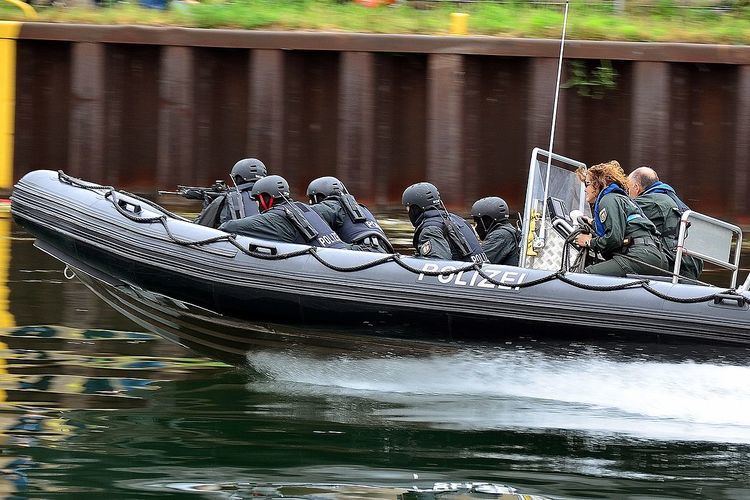Country Germany Type Special forces Current
commander Varies | Branch Varies Size Varies | |
 | ||
Role Domestic Counter-Terrorism and Law Enforcement | ||
Special Deployment Commandos, German: Spezialeinsatzkommandos (SEK) (previously Sondereinsatzkommando which has the same meaning), are the specialized operation armed response units of the sixteen German state police forces.
Contents
- Organization
- Eligibility and training
- Missions
- Equipment
- Uniforms
- MEKs
- Personenschutzkommando
- German Democratic Republic
- References
The comparable units of the German Federal Police are GSG 9 and BFE+.
Organization
The organization of special police forces varies from state to state. Whilst most states have created one Special Deployment Commando which is based in their capital city, others have more than one. North Rhine-Westphalia Police or Rheinland-Pfalz State Police have established Special Deployment Commandos in other major cities as needed. The Bavarian State Police and Hessen State Police both have two Special Deployment Commandos - one each for the north and the south.
A SEK unit can be attached to the (barracked) Rapid Reaction Police or to big regional police headquarters. However, the common trend is to put the SEK units under control of the State Investigation Bureau, whenever possible in a unit also consisting of the Mobiles Einsatzkommando (MEK, mobile special response unit) or other specialized forces like crisis negotiation teams.
The internal organisation of SEKs rests with the units and therefore differs as well.
The SEK of South Bavaria has an alpine component and the SEK units of Bremen and Hamburg have elements trained for maritime tasks. Some SEKs also have specialized negotiation groups (Verhandlungsgruppen, commonly abbreviated as VGs) for cases like hostage situations or suicide attempts.
Eligibility and training
Any state police officer is eligible to apply for service in a SEK unit, but it is common only to consider applications from officers with at least two years of duty experience. The age limit is mostly between 23 and 35 years, whilst operatives have to leave the entry teams when they reach the age of 42 (or 45 in some states). Both sexes can be recruited; however, only a few policewomen have been able to handle the extensive and challenging tests. At the moment, only the SEK units of Hamburg (note: the SEK-equivalent unit in Hamburg is also called MEK), Schleswig-Holstein and Southern Hesse have women in their ranks.
Basically the requirements demand physical and mental strength, discernment and capacity for teamwork. Only about 30 percent of all candidates pass the tests. The length of the training necessary to become an operative in a SEK unit differs but is generally five to eight months long and covers a wide range of required skills.
Missions
Mainly unrecognized by the media and public, the main missions of SEK units are to serve arrest warrants and to deal with barricaded suspects. Hostage sieges, kidnappings and raids also belong to their missions as well as other scenarios like personal security detail for VIPs or witnesses.
Since the 1970s, each SEK has handled several thousand deployments. The front-runner is the SEK of the Berlin Police with up to 500 deployments a year, an average of 1.4 deployments a day.
Equipment
The basic gear for every SEK officer is a standard sidearm and a submachine gun. SEK would gain other weaponry including rifles, sniper rifles, and even machine guns (in some units) depend on the situation encountered.
Unlike other police institutions, members are not bound to normal procurement policies and can order the equipment they feel the best for their mission.
The following are the common weapons used by SEK:
Uniforms
SEK members do not always operate in uniform and wear masks to protect their identities. If cited in a trial they are only referred to by numbers.
When off-duty SEK officers are called to a crime scene, they may appear plain-clothed, only wearing their special protective gear and carrying their weapons.
MEKs
Mobile Task Force units (Mobile Einsatzkommandos or MEKs) operate hand-in-hand with the SEKs.
These plain-clothed units are specialized in surveillance, quick arrests and mobile hostage sieges or kidnappings. They are often used in investigations against organized crime or blackmailers. However, the deployment of the MEK units is requested only for serious offenses.
MEK often, also, provides close protection for the state's senior leaders, including the state's minister president. Requirements for the duty as a MEK officer are similar or partially less strict than the requirements for the SEK.
Personenschutzkommando
The Personenschutzkommando units are plain clothes unit that provide personal security to protect politicians and VIPs.
German Democratic Republic
The SEK units of the states that belonged to the German Democratic Republic prior to 1990 partially consist of officers who were members of East Germany's GSG 9 counterpart, a unit called Diensteinheit IX. DE IX members had to fulfill similar requirements. Alexander Schalck-Golodkowski, the regime's leading trader, purchased West German weapons and ammunition for DE IX in the mid-80s to fill capability gaps.
